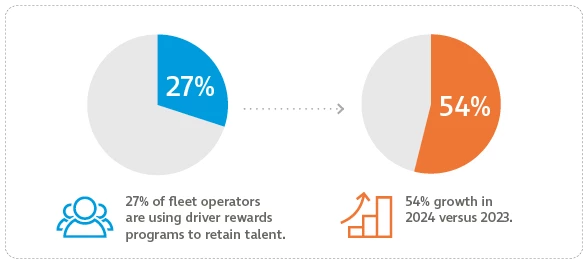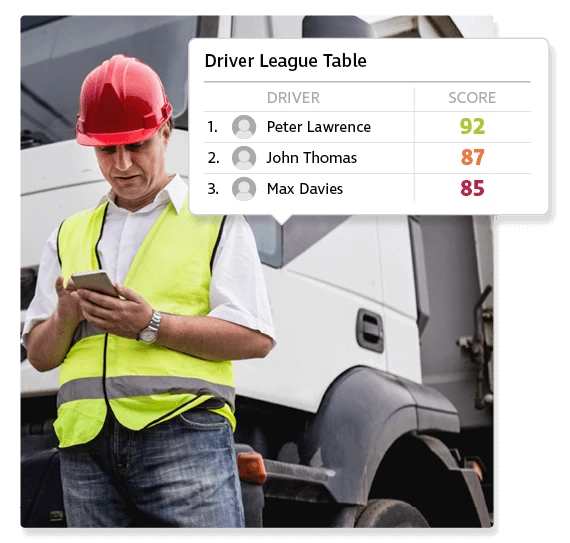Key Takeaways
In logistics and transportation, the key to successful operations lies in the hands of drivers and the goal of all fleet dependent business is to create a harmonious balance between efficiency, safety, and job satisfaction to help retain drivers.
Driver rewards programs are a way of incentivizing drivers to operate in a safe and efficient way and can offer businesses an impressive return on investment. These programs are more than a pat on the back for drivers - they're strategic tools that can significantly impact driver retention, performance and operational cost savings. Here's what you need to know about effective rewards programs and how tools like Teletrac Navman's Driver Scorecard can help you integrate these programs into your management strategy.
Table of Contents
- The Impact of Driver Rewards Programs
- Implementation Strategies and Best Practices
- Tracking Rewards Program ROI
The Impact of Driver Rewards Programs
By recognizing and incentivizing driver achievements, businesses create a positive work culture that contributes to enhanced operational efficiency, improved road safety and increases in job satisfaction.
Improved Driver Retention
Driver retention is essential for any fleet. High driver turnover incurs substantial costs in recruiting and training new drivers which affects the continuity and quality of service. An effective rewards program can keep drivers satisfied and less likely to seek employment elsewhere. This satisfaction comes from feeling valued and recognized, which fosters loyalty to the company.
Additionally, experienced drivers bring expertise and efficiency that is hard to replace. By retaining these skilled professionals, companies ensure a higher standard of service delivery and operational consistency. The knowledge and experience they accumulate over time are invaluable assets that contribute significantly to the smooth functioning of fleet operations. In our 2024 Telematics Survey 27% or fleet operators confirmed that they were running driver rewards programs as part of their driver retention strategy.

Boosting Performance and Safety
Rewards programs focused on performance and safety can lead to a measurable increase in fleet efficiency and reduced accidents. Incentivizing drivers to adhere to safety protocols and efficient driving practices creates a safer working environment and saves costs from fewer accidents and lower insurance premiums.
These programs can also positively impact the company's public image. A fleet known for its safety standards and efficient operations is more likely to attract new business, maintain current customer relations and foster growth. Implementing a driver rewards program signals to customers and the industry at large that the company is committed to excellence and safety in all aspects of its operations.
Operational Cost Benefits
Efficient driving habits, encouraged by a well-structured rewards program, can significantly reduce fuel consumption and vehicle wear and tear. Efficient driving helps boost cost-savings and positions the company as environmentally responsible, which is increasingly important to customers and stakeholders. Efficient operations can mean timelier deliveries and fewer delays, increasing customer satisfaction and loyalty.
Companies can also reduce the frequency and severity of mechanical breakdowns by rewarding drivers for proper vehicle handling and adherence to maintenance schedules. This proactive approach to fleet maintenance ensures that vehicles are consistently in good condition, reducing the likelihood of costly, unexpected repairs, keeping the fleet on the road.
Implementation Strategies and Best Practices
It's vital to strategically implement driver rewards programs to maximize their benefits. This involves understanding the unique needs and motivations of the driver workforce and developing a program that aligns with these insights. Implementation best practices include setting clear, achievable goals, ensuring fairness and transparency in the rewards process, and continuously evaluating and refining the program.

Combining Rewards with Technology
Integrating driver rewards programs with fleet management technology like Teletrac Navman's TN360 can enhance the effectiveness of these programs. Technology can provide accurate and real-time data to monitor driver behavior, ensuring that rewards are distributed fairly and effectively. The more advanced solutions now incorporate integrated camera technology that uses video AI to detect high risk driving behaviors and provide complete transparency into the actions that impact performance scores.
Optimizing Reward Structures
The structure of the rewards program is crucial. It should be designed in an achievable and challenging way, ensuring drivers are motivated to improve their performance. Rewards can be monetary, recognition-based, or provide additional privileges or benefits. The key is understanding what motivates your drivers and tailoring the rewards accordingly.
Addressing Challenges
Implementing a driver rewards program may have challenges, such as ensuring fairness and transparency or aligning the program with business goals. Clear communication and involving drivers in the planning can address these challenges. It’s also important to continuously monitor and adjust the program based on feedback and results to promote driver satisfaction with the rewards program.
Tracking Rewards Program ROI
A driver rewards program should be used as a strategic tool to help a business meet the goals outlined in its fleet management plan. Common goals include driver retention rates, accident rates, fuel consumption, and maintenance cost, and it is key that performance against these goals is measured. With the right fleet management platform this process can be automated making it easy to monitor impact, share performance and drive continuous improvement.

